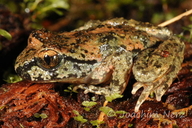|
Ascaphus truei Stejneger, 1899
Pacific Tailed Frog, Coastal Tailed Frog, Western Tailed Frog | family: Ascaphidae genus: Ascaphus |
| Species Description: Stejneger, L. 1899. Description of a new genus and species of discoglossoid toad from North America. Proceedings of the United States National Museum 21: 899.901. | |
 © 2017 Dr. Joachim Nerz (1 of 101) |
|
|
|
Description Distribution and Habitat Country distribution from AmphibiaWeb's database: Canada, United States U.S. state distribution from AmphibiaWeb's database: California, Oregon, Washington Canadian province distribution from AmphibiaWeb's database: British Columbia
Life History, Abundance, Activity, and Special Behaviors Juveniles are sexually mature in 7-8 years. Maximum average Ascaphusdensity per linear meter of stream was 0.162 larvae and 0.035 adults in western Oregon (Bull and Carter 1996). Nussbaum et al (1983) cite densities as high as 1 frog per meter of stream in eastern Washington. Larva Trends and Threats Possible reasons for amphibian decline Habitat modification from deforestation, or logging related activities Comments See another account at californiaherps.com. This species was featured in the News of the Week 14 April 2025: Predicting how populations will respond to environmental change is an inherently complex problem often simplified due to the limitations of particular research approaches. For example, conservation genomics studies often lack insight into phenotypic traits important to environmental tolerance, while physiological studies are often limited to individuals from a single population and lack insight into population variation and the capacity for traits to evolve. Forester et al. (2025) combine conservation genomics and physiological ecology to gain important insights into the climate change vulnerability of two cold water stream frogs (Ascaphus montanus and Ascaphus truei). They developed the first annotated reference genome for A. truei and took advantage of a large data set quantifying thermal tolerance across populations of both species from a diversity of thermal environments. The authors first showed evidence for local adaptation to temperature in both species and a genetic basis to critical thermal maximum temperature (CTmax), a common metric to assess thermal tolerance. Importantly, by examining population variation, they were able to conclude that Ascaphus montanus populations appear to exhibit adaptive divergence in CTmax, such that populations have similar vulnerability to future warming. In contrast, Ascaphus truei showed only genomic evidence for local adaptation and no divergence in CTmax. A similar sensitivity to high temperatures across populations means that A. truei populations occupying warmer streams (e.g., low elevation) are closer to their upper tolerance limits and thus more vulnerable to future warming compared to populations occurring in colder streams (e.g., high elevation). The real-world implications of these results mean that management decisions used to mitigate the impacts of future warming on Ascaphus montanus may differ for Ascaphus truei, although both species appear to have high levels of evolutionary potential based on the genomic and physiological data. (Written by Chris Funk)
References
Bull, E. L. and Carter, B. E. (1996). ''Tailed Frogs: Distribution, ecology, and association with timber harvest in Northeastern Oregon.'' United States Forest Service Research Paper, (497), 1-12. Ford, L.S., and Cannatella, D.C. (1993). "The major clades of frogs." Herpetological Monographs, 7, 94-117. [link] Nussbaum, R. A., Brodie, E. D., Jr., and Storm, R. M. (1983). Amphibians and Reptiles of the Pacific Northwest. University of Idaho Press, Moscow, Idaho. Orchard, S.A. (1992). ''Amphibian population declines in British Columbia.'' Declines in Canadian amphibian populations: designing a national monitoring strategy. C. A. Bishop nd K.E. Petit, eds., Canadian Wildlife Service, 10-13. Stebbins, R. C. (1985). A Field Guide to Western Reptiles and Amphibians. Houghton Mifflin, Boston. Stebbins, R. C. (2003). Western Reptiles and Amphibians, Third Edition. Houghton Mifflin, Boston. Stebbins, R.C. (1951). Amphibians of Western North America. University of California Press, Berkeley. Wallace, R. L. and Diller, L. V. (1998). ''Length of the larval cycle of Ascaphus truei in coastal streams of the redwood region, northern California.'' Journal of Herpetology, 32(3), 404-409. Originally submitted by: Alan Krakauer, Meredith J. Mahoney (first posted 1999-02-16) Description by: Michelle S. Koo (updated 2025-04-13)
Distribution by: Michelle S. Koo (updated 2025-04-13)
Life history by: Michelle S. Koo (updated 2025-04-13)
Larva by: Michelle S. Koo (updated 2025-04-13)
Trends and threats by: Michelle S. Koo (updated 2025-04-13)
Comments by: Michelle S. Koo (updated 2025-04-13)
Edited by: Duncan Parks and Meredith J. Mahoney, Michelle S. Koo (2025-04-13) Species Account Citation: AmphibiaWeb 2025 Ascaphus truei: Pacific Tailed Frog <https://amphibiaweb.org/species/2049> University of California, Berkeley, CA, USA. Accessed Jun 12, 2025.
Feedback or comments about this page.
Citation: AmphibiaWeb. 2025. <https://amphibiaweb.org> University of California, Berkeley, CA, USA. Accessed 12 Jun 2025. AmphibiaWeb's policy on data use. |




 Map of Life
Map of Life